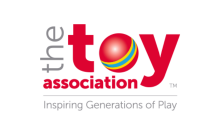Children learn best through play and STEAM (Science, Technology, Engineering, Arts, and Mathematics) is no exception. Playful STEAM learning is characterized by hands-on exploration, problem-solving, and meaningful interdisciplinary projects. In preparation for our upcoming webinar together, I recently had the pleasure of sitting down with Anna Yudina, the Senior Director of Marketing Initiatives at the Toy Association. I chatted with Anna to get her perspective on how toys can help encourage playful STEAM learning. Read on to hear her ideas about how toys can help break stereotypes, support the sciences, and more!
Amanda: Can you tell me about the Toy Association and the work you do?
Anna: Spearheading the benefits of play is an important part of our mission at The Toy Association. We do that in many ways, including The Genius of Play initiative, which has reached millions since its launch in 2015. The Genius of Play started as a movement to educate parents and caregivers about the benefits of play. We have been collaborating with child development experts and sharing research and facts that support the need for playful learning and just play in general.
Over the years, The Genius of Play has evolved into a leading resource of play ideas and activities for families. Our website www.thegeniusofplay.org houses hundreds of activities organized by a child’s age and developmental benefit. We also have a special section dedicated to educators where teachers, afterschool professionals and other adults who work with kids can discover play-based lesson plans focused on everything from math to literacy to science.
Amanda: What is the role of toys in STEAM learning?
Anna: Toys get kids involved and passionate about STEAM subjects and help relate complex and often abstract concepts to the world around them. Subjects like math and science become relevant to things they experience every day, such as cooking, shopping, or building.
STEAM toys also encourage trial-and-error and through this type of play, kids learn how to fail and still have fun. These skills are fundamental to future success in STEAM subjects in school or careers where one needs to experiment all the time to discover solutions to problems. Toys teach kids to take healthy risks in a non-threatening, playful environment, then transfer that confidence and courage to their future endeavors.
Finally, toys and play have the power to spark young imaginations and nurture innovative thinking. The Toy Association has created a handy infographic to illustrate the Top 10 Ways Toys Can Teach STEAM. I encourage you to check it out!
Amanda: Can you explain the Toy Association's STEAM Accreditation?
Anna: The STEAM Accreditation is the toy industry’s first-ever official program designed to evaluate toys using strict guidelines and a rigorous, scientifically proven toy assessment method. It is based on the criteria outlined in The Toy Association’s STEAM Toy Assessment Framework, which defines and details specific characteristics of a good STEAM toy for various age groups.
Every toy submitted for evaluation is first tested by the important people – children. While the kids play, they are observed by professionals who have been trained to carry out research with children in a robust and ethically responsible way. The toys are then evaluated by the team of experts at the Good Play Guide – our official accreditation partner – to ensure they meet the strict criteria set in the framework.
With so many toys available, it can be a challenging task to find the ones that truly stand out for their educational value. The STEAM Accreditation makes it easier for educators and caregivers to find high-quality STEAM toys. The Toy Association has also partnered with Amazon to create the STEAM Accredited Toys Storefront, which features a wide selection of officially accredited toys.
Amanda: How does the work you do help support equity in STEAM education?
Anna: Toys can help combat stereotypes and foster diversity of cultures and perspectives, and they can influence kids from a very young age. When I was a little girl, there were separate boy and girl aisles in toy stores, and there were strong perceptions around which toys were “appropriate” for each gender. I had a passion for biology from an early age, but it took years before I finally got a toy microscope while I always had an army of dolls and stuffed animals.
It makes me very happy to see how things have been changing, with more and more toys now actively embracing and promoting diversity and inclusion. We know from research that having role models who look just like us matters so it is important for kids to know that people who work in STEAM fields come from all kinds of backgrounds, genders, and skin colors. Seeing their toys reflect this diversity can provide that little bit of extra confidence and motivation to help today’s kids imagine themselves as someday being scientists, engineers, technology experts or mathematicians.
Amanda: Are there any other resources or tips do you want to share?
Anna: Kids are naturally curious and want to explore the world around them, so tapping into that curiosity and encouraging discovery and experimentation through age-appropriate, play-based activities is really the best way. Simple experiments like Fireworks in a Jar are appropriate for kids as young as three.
If you are looking for more ideas like this, thegeniusofplay.org is a great resource. For example, Playing with STEM at Home for Young Learners shares fun activities and experiments such as Cabbage Colors, 3D Shapes, A Boat That Floats, and more. We are also working on a brand-new “STEAM Playbook” in collaboration with NGCP, which will feature a curated collection of play activities for every letter in S-T-E-A-M. It will be available on our website starting November 8, just in time for the National STEM/STEAM Day celebration!
Want to learn more? Join Anna and I, along with other exciting speakers, for our upcoming webinar “The Genius of Play and STEAM” on National STEAM Day! Register here.


